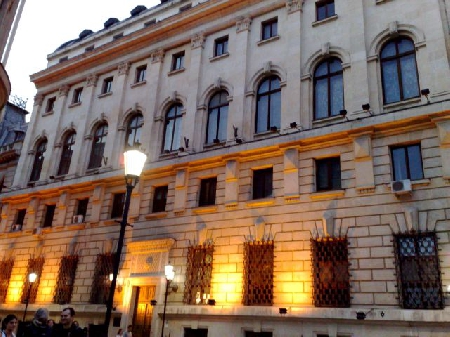The Chrissoveloni Bank and Family
In the old center of Bucharest, near the shopping area traditionally known as “Lipscani, there is also the capitals financial district, the place where the head offices of the National Bank of Romania and of key banks for the countrys economic history

Christine Leșcu, 30.03.2013, 17:45
Historian Dan Falcan tells us more about its owners, the Chrissoveloni family: “Chrissoveloni Bank had a century-old tradition in Romania. The founder of this banking and industrial empire was a Greek, Zannis Chrissoveloni. He started his business in 1830 in Constantinople. Later, in 1848, he moved to the Romanian Principalities, where he set up a bank and an export company in Galati. His operations gradually developed, and he opened several branches in Braila and Bucharest. In 1881 his bank merged with another bank, and in 1889 we already had the Chrissoveloni Bank in Bucharest. The business had been taken over by the founder’s son, Nicolas Chrissoveloni.”
Over the years, the bank thrived, growing into one of Romania’s chief banks. Meanwhile, the family also invested in real estate, industry and agriculture.
According to historian Dan Falcan, this boom occurred especially after World War One: “After World War One, the business was run by Jean and Dumitru, particularly Jean, although he died at only 46 years of age. He is the one who built the now famous office building in Lipscani. The architect was the great G.M. Cantacuzino, and the style is late Renaissance. The building is splendid, indeed. Unfortunately, the economic crisis of 1929 came. Since the family was involved in a lot of real estate and industrial deals, they experienced cash shortages, and as the Romanian and world economy collapsed, the bank started having problems. During the management of Jean Chrissoveloni, the family business had spread around Europe. They had offices in Paris, London, in Athens, and in New York. They had bought land in Romania, Greece, Macedonia.”
In designing the Chrissoveloni building, architect G. M. Cantacuzino worked with August Schmiedigen. Inaugurated in 1928, the building resembles an impressive Florentine palazzo. The economic crisis, which started only one year later, severely hit the bank. But thanks to the administrative skills of its managers, it made it through, and did so quite honorably.
Here is historian Dan Falcan again: “Unfortunately, Jean Chrissoveloni had died in 1926. His son, Nicky, went into business at an early age. He was born in 1909, and when the crisis began, he was a student at Oxford. He returned to Romania only in 1931, and that very year, at the age of 22, he joined the board of directors, and in 1936 became chairman of the board. During the crisis the bank was headed by Dimitrie Ghica, and his approach was faultless. The family made desperate efforts to avoid going bankrupt. Nicky Chrissoveloni put his personal wealth at stake. He paid withdrawal claims from his own money, he reduced the share capital by 250 million lei, he covered 95% of the customers’ claims. So in 1934, although substantially weakened, Chrissoveloni bank was declared sound and viable by the National Bank of Romania. It took a lot of sacrifice, but they managed to save the bank.”
Under Nicky Chrissoveloni’s management, the bank regained its reputation and leading position in the Romanian banking system. This Romanian financial institution was actually so strong, that on June 3rd, 1948, the bank’s annual report for 1947 indicated profits of 2 billion lei. This did not prevent the communists from nationalizing it 8 days later. Nicky Chrissoveloni was arrested shortly after, and after 1960 he and his family left the country for Greece. The building on Lipscani street was renovated several years ago, and today it is a landmark of the capital city’s financial center.





























